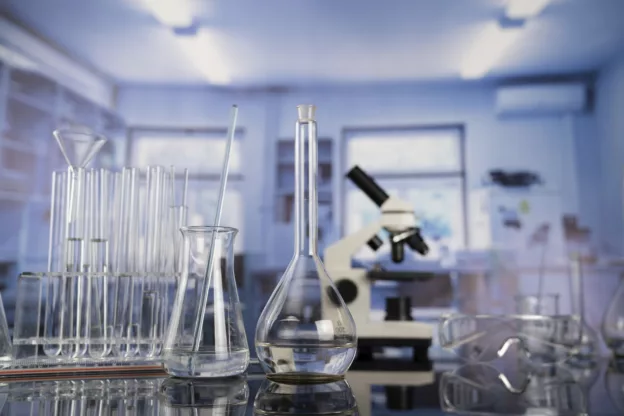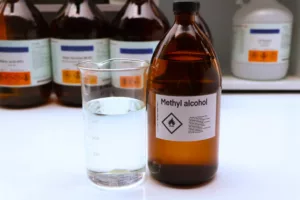Based on OSHA’s Laboratory Safety Chemical Hygiene Plan (CHP) Fact Sheet FS-3461 8/2011
OSHA’s Occupational Exposure to Hazardous Chemicals in Laboratories, 29 CFR 1901.1450 can be accessed through: https://www.osha.gov/SLTC/laboratories/index.html
OSHA’s Occupational Exposure to Hazardous Chemicals in Laboratories standard (29 CFR 1910.1450), referred to as the Laboratory standard, specifies the mandatory requirements of a Chemical Hygiene Plan (CHP) to protect laboratory workers from harm due to hazardous chemicals. The CHP is a written program stating the policies, procedures and responsibilities that protect workers from the health hazards associated with the hazardous chemicals used in that particular workplace.
| Required Elements | |||
| 1 | Standard operating procedures relevant to safety and health considerations for each activity involving the use of hazardous chemicals. | ||
| 2 | Criteria that the employer will use to determine and implement control measures to reduce exposure to hazardous materials [i.e., engineering controls, the use of personal protective equipment (PPE), and hygiene practices] with particular attention given to selecting control measures for extremely hazardous materials. | ||
| 3 | A requirement to ensure that fume hoods and other protective equipment are functioning properly and identify the specific measures the employer will take to ensure proper and adequate performance of such equipment. | ||
| 4 | Information to be provided to lab personnel working with hazardous substances include: | ||
| 4a | The contents of the Laboratory standard and its appendices. | ||
| 4b | The location and availability of the employer’s CHP. | ||
| 4c | The permissible exposure limits (PELs) for OSHA regulated substances or recommended exposure limits for other hazardous chemicals where there is no applicable OSHA standard. (NOTE: NYS PELs can be found at https://labor.ny.gov/formsdocs/wp/Part%20800.5.pdf and differ from the OSHA PELs. NYS PESH will enforce NYS PELs.) | ||
| 4d | The signs and symptoms associated with exposures to hazardous chemicals used in the laboratory. | ||
| 4e | The location and availability of known reference materials on the hazards, safe handling, storage and disposal of hazardous chemicals found in the laboratory including, but not limited to, the Safety Data Sheets received from the chemical supplier. | ||
| 5 | The circumstances under which a particular laboratory operation, procedure or activity requires prior approval from the employer or the employer’s designee before being implemented. | ||
| 6 | Designation of personnel responsible for implementing the CHP, including the assignment of a Chemical Hygiene Officer and, if appropriate, establishment of a Chemical Hygiene Committee. | ||
| 7 | Provisions for additional worker protection for work with particularly hazardous substances. These include “select carcinogens,” reproductive toxins and substances that have a high degree of acute toxicity. Specific consideration must be given to the following provisions and shall be included where appropriate: | ||
| 7a | Establishment of a designated area. | |
| 7b | Use of containment devices such as fume hoods or glove boxes. | |
| 7c | Procedures for safe removal of contaminated waste. | |
| 7d | Decontamination procedures. | |
| 8 | The employer must review and evaluate the effectiveness of the CHP at least annually and update it as necessary. | |
| Worker Information and Training must include: | ||
| 9 | Methods and observations that may be used to detect the presence or release of a hazardous chemical (such as monitoring conducted by the employer, continuous monitoring devices, visual appearance or odor of hazardous chemicals when being released, etc.). | |
| 10 | The physical and health hazards of chemicals in the work area. | |
| 11 | The measures workers can take to protect themselves from these hazards, including specific procedures the employer has implemented to protect workers from exposure to hazardous chemicals, such as appropriate work practices, emergency procedures, and personal protective equipment to be used. | |
| 12 | The applicable details of the employer’s written CHP. | |
| 13 | Required information and training must be provided at the time of an employee’s initial assignment to a work area where hazardous chemicals are present and prior to assignments involving new exposure stations. The frequently of refresher information and training will be determined by the employer. | |
| Medical Exams and Consultation | ||
| 14 | The employer must provide all personnel who work with hazardous chemicals an opportunity to receive medical attention, including any follow-up examinations which the examining physician determines to be necessary, under the following circumstances: | |
| 14a | Whenever a worker develops signs or symptoms associated with a hazardous chemical to which the worker may have been exposed in the laboratory, the worker must be provided an opportunity to receive an appropriate medical examination. | |
| 14b | Where exposure monitoring reveals an exposure level routinely above the action level (or in the absence of an action level, the PEL) for an OSHA regulated substance for which there are exposure monitoring and medical surveillance requirements, medical surveillance must be established for the affected worker(s) as prescribed by the particular standard. | |
| 14c | Whenever an event takes place in the work area such as a spill, leak, explosion or other occurrence resulting in the likelihood of a hazardous exposure, the affected worker(s) must be provided an opportunity for a medical consultation to determine the need for a medical examination. | |
| 14d | All medical examinations and consultations must be performed by or under the direct supervision of a licensed physician and be provided without cost to the worker, without loss of pay and at a reasonable time and place. | |
| 15 | All employee medical records must be maintained in compliance with 29 CFR 1910.1020. | |
OSHA Fact Sheets on Laboratory safety
Laboratory Safety: Autoclaves/Sterilizers Quick Facts
(OSHA 3405 – 2011) (English: PDF)
Laboratory Safety: Biosafety Cabinets (BSCs) Fact Sheet
(OSHA FS-3460 – 2011) (English: HTML PDF)
Laboratory Safety: Centrifuges Quick Facts
(OSHA 3406 – 2011) (English: PDF)
Laboratory Safety: Chemical Fume Hoods Quick Facts
(OSHA 3407 – 2011) (English: PDF)
Laboratory Safety: Chemical Hygiene Plan (CHP) Fact Sheet
(OSHA FS-3461 – 2011) (English: HTML PDF)
Laboratory Safety: Cryogens and Dry Ice Quick Facts
(OSHA 3408 – 2011) (English: PDF)
Laboratory Safety: Electrical Hazards Quick Facts
(OSHA 3409 – 2011) (English: PDF)
Laboratory Safety: Ergonomics for the Prevention of Musculoskeletal Disorders Fact Sheet
(OSHA FS-3462 – 2011) (English: PDF)
Laboratory Safety: Labeling and Transfer of Chemicals Quick Facts
(OSHA 3410 – 2011) (English: PDF)
Laboratory Safety: Latex Allergy Quick Facts
(OSHA 3411 – 2011) (English: PDF)
Laboratory Safety: Noise Fact Sheet
(OSHA FS-3463 – 2011) (English: PDF)
Laboratory Safety: OSHA Laboratory Standard Fact Sheet
(OSHA FS-3464 – 2011) (English: PDF)
Laboratory Safety: Working with Small Animals Quick Facts
(OSHA 3412 – 2011) (English: PDF)
Other References:
Dow Lab Safety Academy
https://www.dow.com/en-us/science-and-sustainability/safety
OSHA Publications Fact Sheets (HTML)
UC Center for Lab Safety https://cls.ucla.edu















